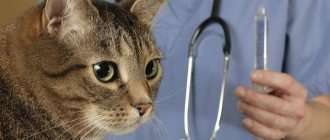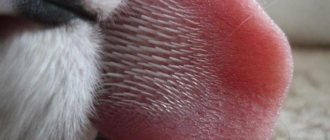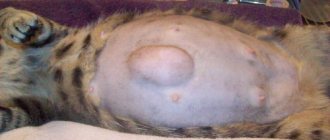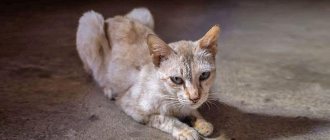Causes of alopecia
The reasons why a cat develops a bald spot behind the ear, or only the tips of the hearing organs are hairless, can be very diverse. It is worth considering the most common among them.
Genetic abnormalities
Hypotrichosis is considered a genetic, inherited disorder. As a rule, it manifests itself at an early age. Kittens remain without fur, and then grow it again.
The pathology is extremely rare and does not pose a threat to the pet’s life. True, it is practically not amenable to therapy. Such cats are not allowed for breeding.
Avitaminosis
The cat's body does not produce vitamin A.
The animal receives it with food. If there is a shortage of this substance, the condition of the coat and skin worsens, and the appearance of baldness is possible.
Obesity
With excess body weight, the sebaceous glands become inflamed and dermatitis develops. Alopecia is also possible.
Due to the fact that the cat cannot provide adequate care for its fur, baldness occurs.
Such a pet needs to be given special food that helps reduce body weight.
Psychological alopecia
Sometimes baldness occurs in animals that are under stress.
When nervous, the cat begins to calm itself down through constant licking. But if you suspect psychogenic alopecia, you should not exclude an allergic reaction, which can also lead to baldness .
Reaction to medications taken
Bald spots in the ear area can appear as a result of taking medications.
If such a reaction occurs, you should contact your veterinarian and replace or completely discontinue the drug.
Helminthiasis
When the body is infected with worms, metabolic processes are disrupted and the immune system is suppressed. A deterioration in the condition of the coat indicates helminthic infestation. In neglected situations, bald spots appear.
Failure of the endocrine system
With endocrine disorders, bald areas also appear. Disturbances in the activity of the thyroid gland, problems with the adrenal glands, sterilization and diabetes can lead to hormonal imbalance.
Infectious alopecia
The appearance of bald areas on the ears is often observed when an infection enters the body. It can affect the respiratory tract, intestines or eyes.
To choose treatment tactics, you must consult a veterinarian.
Lichen
The pathology is caused by fungi and poses a serious danger to people.
The disease manifests itself in the form of bald round areas on which there are remnants of hair (their root part). The skin is covered with scales. The pet suffers from severe itching and scratches the affected areas. Gradually they become larger.
Mechanical factor
This type of baldness is the easiest to eliminate.
Bald spots can appear after a fight with other animals or injury. Special therapy is not required in this case.
Over time, the condition will normalize and new hair will grow.
Skin diseases
If crusts suddenly appear on a cat’s ears, the animal behaves lethargically, refuses to eat and sleeps a lot - the reason should be sought in a decrease in immunity. This may be accompanied by the formation of crusts on the face and thinning of the coat.
Ears are a kind of marker of the general condition of a cat’s body. In the event of an allergic reaction, this delicate part of the body is the first to react. Allergies can be caused by:
- changing your diet;
- contact with household chemicals;
- reaction to drugs;
- climate change.
Small kittens and older animals react very sharply to changes in diet. Feeding a new food, switching to natural food - all this can cause food allergies.
Cats are curious animals, which is why they often come into contact with household chemicals and other irritating substances. Contact of washing powder and other household products on an animal's skin can cause an allergic skin reaction.
Often the appearance of crusts on the ears and face of a pet is due to a reaction to drugs. First of all, they release anti-flea products that drip onto the withers. They can be toxic, which is manifested by a specific allergic reaction in the form of crusts and bald patches on the ears.
A fairly rare cause of the appearance of crusts on the tips of the ears of a furry pet is solar eczema. The disease is a consequence of the skin's reaction to ultraviolet radiation. Smooth-haired animals and breeds without hair are more susceptible to this dermatological reaction. An important factor in the development of photodermatitis is the color of the ears and fur - this disorder is usually characteristic of white cats with pink skin.
You might be interested in: What to do if your cat has a bald spot?
Symptoms You Shouldn't Ignore
If the animal notices the appearance of completely bare areas of the skin or is covered with excessively sparse hair, then it is necessary to consult a doctor. Also of concern are peeling, redness, itching and crusting.
All these symptoms cannot be ignored: there is a high probability that your pet is developing a serious illness.
Diagnostic methods
If your cat's ears are going bald, there is brown discharge from the ears and redness of the skin, then you should contact a veterinarian for help. The specialist will examine the area with lost hair and become familiar with the symptoms that are bothering the pet. If it is not possible to visually determine the cause and severity of the disease due to which the bald spot appeared, then additional diagnostic procedures are prescribed. To make a diagnosis, the following manipulations may be required:
- laboratory testing of blood and urine;
- bacterial culture of urine;
- scraping from the damaged area with further microscopy;
- ultrasound diagnostics of internal organs if there is a suspicion of a violation of their function;
- allergic reaction test.
How to help a cat
Treatment is selected taking into account the general health of the pet and the factors that provoked baldness.
Medications
After determining the cause of baldness, certain groups of drugs are prescribed:
Allergy. Immunostimulating and antihistamines are prescribed.- Parasites. They resort to the use of antiparasitic drugs.
- Infection. Antibiotics are used, for example Amoxicillin.
- Stress. Drugs that have a sedative effect are used.
- Lichen. Antifungal agents are prescribed. The most commonly used are Ketoconazole or Griseofulvin. In addition, agents are used that stimulate metabolic processes and support immunity.
- Endocrine system disorders. Hormonal medications are indicated.
Traditional medicine
Resorting to the use of folk remedies is strongly discouraged. Often, when using them, there is a deterioration in the animal’s condition.
In addition to drug therapy, it is worth excluding potential allergens from your pet’s menu and providing him with peace. Self-medication is strictly prohibited .
What is the normal coat of hair on a cat's ears and above the eyes?
Before diagnosing your pet yourself, it is worth clarifying what the hair on the face of a healthy animal should look like. Are small bald spots under the eyes and ears of an animal a sign that it is going bald?
According to the observations of felinologists, the presence of small “gaps” in the fur on a cat’s temples is an absolute norm. If you look closely at the pet, it turns out that the bare “spots” found on its face are bald patches in the usual sense of the word, but just areas covered with lighter, shorter and sparse (compared to the rest of the head) hairs.
It is easy to make sure that small bald spots on the temples are a physical feature characteristic of a biological species, and not a sign of a disease. Suffice it to remember that hairless spots on the pet’s face were always present - both when he was a kitten and when he became an adult.
How to accurately determine the cause
In order to make an accurate diagnosis, the doctor examines the animal, listens to the owner’s complaints, and takes an anamnesis.
Additional diagnostic procedures may be prescribed:
study of hair follicles;- blood analysis;
- determination of hormone levels;
- skin scraping;
- X-ray;
- Ultrasound.
Baldness treatment
If the owner notices that the cat's ears are peeling, the pet is immediately taken to the doctor.
The veterinarian performs a number of manipulations:
- Examines the cat for parasites.
- Takes a skin scraping to determine a skin infection.
- Performs a blood test to detect inflammation in the pet's body.
- Conducts an analysis of the animal's hormonal levels.
- Additional studies may be performed to clarify the diagnosis.
Based on the examination results, the doctor prescribes home treatment and advises the owner on the cat’s nutritional issues.
Vaccinating your cat helps against diseases that cause hair loss
Prevention measures
To avoid hair problems, you need to follow these recommendations:
- choose high-quality food that matches the condition and age of the cat;
Give your pet antihelminthics at intervals of three months;- regularly treat the animal for fleas;
- eliminate all factors that can lead to the development of allergies;
- vaccinate in a timely manner;
- provide your pet with complete care.
The cat's hair is coming out: what to do?
Since hair loss in cats in clumps can be caused by a number of reasons, it is impossible to diagnose the disease on your own. The doctor additionally needs to conduct a comprehensive analysis to establish the true cause of such symptoms. Only one thing is required from a caring owner - show the pet to the doctor. It is advisable to observe your ward for some time so that you can answer all the veterinarian’s questions. You may be asked questions of the following nature: how long has he been going bald, what do you feed your pet, what medications have you been given recently, has your pet had vomiting or diarrhea, is he trying to gnaw the spine with his teeth or pull out hair, does he have a fever, is he allowed to Is he going outside or not, do you give him hormonal medications and other similar questions.
Fungal dermatitis
Fold cats are predisposed to Malassezia otitis.
The yeast fungus Malassezia is a permanent inhabitant of the cat's skin. In individuals with immunity weakened by the underlying disease, when kept in conditions of heat and high humidity, yeast begins to multiply.
The ear canal is affected. The cat scratches the itchy area, the ichor comes out, dries out, and crusts form. Fold-eared cats are predisposed, as are pets with large ears. Treatment is prescribed by a veterinarian. These are drugs that eliminate the underlying disease, external or systemic antimycotics.
Be sure to read:
The cat is limping on its hind leg without visible damage and shaking its paw or pulling it back
Prevention involves regular ear cleaning.
Signs of the described deviations
Peeling of the skin is accompanied by the appearance of dandruff throughout the animal's body. Most often, the main areas of damage are the back and the area near the tail. The main signs of peeling skin and hair loss include:
Almost always, flaking and baldness are accompanied by itching, the presence of which affects the condition of the pet’s skin - it worsens significantly. In addition, the entry of bacteria into scratched wounds leads to the development of inflammatory processes on the skin.
Rare causes of patchy hair loss in cats
It happens that the reason for the formation of a bald spot on a cat’s ear, temple or face is so rare and unusual that even experienced veterinarians initially find it difficult to diagnose it. These include:
- heredity;
- individual genetic mutations;
- adenitis;
- hyperplasia.
Technically, the cause of baldness can be any pathology - from bacterial or viral infections to cancerous tumors. All of them damage the immunity of a living creature. When there are too many such negative influences, the body begins to experience a lack of resources for recovery. By “saving” on what is not so necessary, the body “turns off” some of its functions, for example, maintaining a healthy coat. In cats, this can cause, among other things, alopecia areata.
Bald spots on the paws and stomach: photos, causes, advice from veterinarians
A lot has been written here about feeding cats. He has already accumulated it both from old age and from improper feeding. I would remove boiled crucian carp and sausage from the table and choose medicinal professional premium food, or only in nature (but you have to weigh everything with a scale and cook it once a week). Our friends have a 14-year-old cat - the hair was peeling off from the ears and legs, itching until it bled - they fed it haphazardly, after they switched it to normal food, the cat came into divine shape. Here. My point is that animal nutrition is of primary importance for health. Everything is the same as with people.
Yanchik, put the cat on a diet, this is advisable. Try to replace the fish with boiled chicken, or lean beef. Fish, especially river fish, is not suitable for feeding cats, especially at this age. Try to remove sausages altogether, there are a lot of substances that are harmful to people, not just cats. Curdled milk, egg, low-fat cottage cheese, chicken, beef, chicken heart and gizzards, all boiled, but what am I telling you, read our threads about feeding natural and industrial feeds, choose what suits you. It is necessary to have blood analyzed and scraped for culture; without this, who will figure out what to treat the cat for. Consider age, this is also important, because an animal at that age needs, just like a person, a certain diet and care.
Thank you very much for the advice) we will definitely listen: smile:











